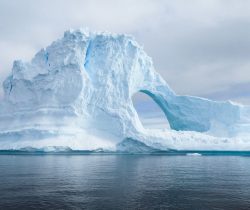
The Antarctic saw a series of extreme events over 2022: simultaneous heatwaves in Antarctic and Arctic, a major collapse of the Conger ice shelf in East Antarctica and record low Antarctic sea ice observations.
In March 2022, the Antarctic experienced a heatwave. Warm moist air became trapped over East Antarctica by a blocking high pressure system resulting in temperatures over 50°C above average in some areas. A new record March maximum temperature was set with some locations warm enough for the surface of the ice and coastal ice shelves to melt.
At the same time, in March 2022, a large area of the East Antarctic ice shelf, the size of New York City, collapsed. The extreme heat in 2022 contributed to the rapid destabilisation and collapse of the Conger ice shelf, and it remains to be seen if the ice shelf will reform over coming years or if it will remain lost like some collapsed ice shelves in other regions of Antarctica.
Rapid declines in sea ice from spring 2021 continued, leading to record low extent in late summer 2021-22.
Main research contact: Professor Julie Arblaster | julie.arblaster@monash.edu and Dr Amelie Meyer | amelie.meyer@utas.edu.au
The State of Weather and Climate Extremes 2022
Weather and climate extremes in Antarctica
Extreme events in 2022
Heatwaves in Western Australia
Extreme rainfall and flooding in Queensland and New South Wales February-March 2022
Record low Antarctic sea ice extent in 2022
Simultaneous Antarctic and Arctic heatwaves
Collapse of East Antarctic Conger ice shelf
Hailstorms in Queensland, Victoria and New South Wales
Damaging wind gusts in South Australia and the Northern Territory
© 2023 ARC Centre of Excellence for Climate Extremes
References and acknowledgements available in the PDF version available here.
Materials used are for educational purposes and either author provided or used under fair dealing provisions.
